“It’s your fault,” the boy’s elderly guardian tells him when he returns home, bloody and petless. No matter: She’s dead in her chair a few minutes later. Next goes the house, swallowed by flames, and suddenly the boy is alone and homeless, forced to cross an inhospitable world in search of sanctuary. Within minutes, he’s wrapped in a burlap bag and whipped by superstitious villagers, screaming in an Interslavic language (never before heard on screen, press notes cheerfully inform) of the evil they believe has possessed him. The boy will, from here, be threatened, throttled, overworked, dangled from the rafters, buried up to his neck in dirt, pecked by ravens, and much, much worse.
One could go on. The movie certainly does. It’s a marathon of murder, mutilation, rape, pedophilia, and bestiality. The Holocaust itself is basically a subplot: Though the landscapes and lifestyles at times look downright medieval, the film actually unfolds across Eastern Europe circa the Second World War, occasionally drifting from the main story to dramatize, say, a failed escape from a Deutsche Reichsbahn train. (We eventually learn that the boy’s parents disappeared when Hitler’s final solution reached their doorstep.) This episodic misery, this odyssey of suffering, comes from an acclaimed novel by Being There author Jerzy Kosinski. Like much of the Polish-American writer’s work, the book was embroiled in authorship controversy—in this case, the revelation that its litany of horrors were not, as Kosinski initially suggested, autobiographical. Perhaps that deserves more relief than outrage; by the final scene, who wouldn’t be glad to know this didn’t actually happen to someone?
Strange as it is to say about a movie that runs 170 minutes, The Painted Bird is economical, in its own exhausting way. Director Václav Marhoul keeps everything chugging along, from one injustice to the next, each step of the journey sketched in quick, harsh brushstrokes. Appearing among the ensemble of wearied European countenances are some familiar faces, each belonging to an international movie star: Stellan Skarsgård as a merciful Nazi, Harvey Keitel as a kindly but oblivious priest, Barry Pepper—in a callback to his role in a more sentimental depiction of WWII’s horrors—as a steely sniper. These cameos are less distracting than the ones in 1917—and thank God that The Painted Bird doesn’t attempt to work all its hellish sights into a single shot.
One might think of Come And See, Elem Klimov’s ceaselessly harrowing drama of contemporaneous atrocity—the rare war movie that’s legitimately, unquestionably anti-war. But that film immersed viewers in not just the violence but also the psychological ordeal of its grim circumstances. The Painted Bird hovers at a distance, dispassionately cataloguing traumas. Its protagonist is more like the perpetually brutalized donkey of Bresson’s Au Hasard Balthazar, passed from one unkind keeper to the next. Kosinski’s novel provided us his first-person impressions on the mistreatment. Here, he’s just a silent, resilient husk—less a character than a shambling embodiment of shattered innocence. His only real trait is an affection for animals, so of course he will be rigorously, methodically disabused of it; on top of all the human casualties, The Painted Bird erects a pile of animal corpses, snapping equine necks and—in the metaphoric moment that provides the story its title—sending a marked bird into a flock that takes it for an intruder. We really know the boy’s been reshaped by his awful experiences when he vindictively beheads a goat.
All of this agony is captured with great skill and artistry. Shot in Cinemascope, in crisp 35mm black-and-white, The Painted Bird is beautiful just to look at, even when its content is unspeakably ugly; there are images that will burn themselves onto your memory, whether you want them to or not. Yet the film’s emotional spectrum, a flat line of unyielding despair, is as limited as its color palette. And it settles into a pattern so dispiritingly repetitive (and repetitively dispiriting) it begins to resemble self-parody: How many times can we watch this boy begin to adjust to a new home, only to discover that the adult taking him in is as sadistic or broken as the last? The Painted Bird is, in the end, the kind of slog that treats shopworn insights about the brutality of man as justification for drowning us in the evidence—like, for example, an early scene of Udo Kier, in the most disturbing of the cameos, carving out a man’s eyeballs with a spoon. Two hours and change later, you might envy that man.













![HBO teases new Euphoria, Larry David, and much more in 2026 sizzle reel [Updated]](https://img.pastemagazine.com/wp-content/avuploads/2025/12/12100344/MixCollage-12-Dec-2025-09-56-AM-9137.jpg)




























